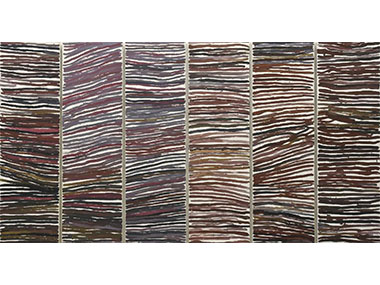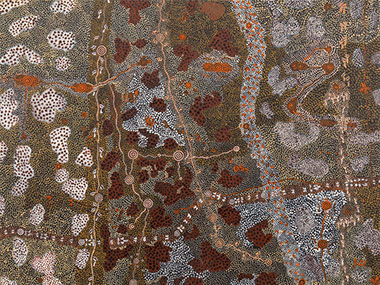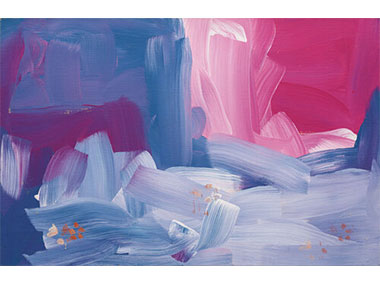EMILY v CLIFFORD

The magnificent 6-panel 'Untitled' (Awelye) from 1994 which went to the Venice Biennale and is now valued at what would be a new record for Emily of of A$3million
Posted by Jeremy Eccles | 03.03.20
Dates:
05.03.20
: 21.03.20
Location: Utopia Arts Gallery, 983 Bourke Street, Waterloo, Sydney, Australia; D'Lan Davidson, High Line Nine, 507 West 27th Street, New York
Who will emerge from the next couple of weeks as the dominant figure – Emily Kngwarreye or Clifford Possum? This pair of the greatest, now-dead Aboriginal artists could not have imagined such a competition; but circumstances in New York and Sydney are pushing both their reputations into the stratosphere – which is a delight to report.
The facts: On Thursday in New York (at High Line Nine, 507 West 27th Street, NY), the entrepreneurial D'Lan Davidson is trebling up on his close associations with the actor/writer Steve Martin and the big Gagosian exhibition of Desert art last year in NY by holding his own selling show of Emily Kngwarreye and a selection of Papunya artists which include an undiscovered masterpiece by Clifford Possum. Given its recognition by the former PTA art advisor John Kean and the authority of his catalogue essay, it may well take the shine off some beautiful Emilys for sale both there and at the Utopia Art Gallery in Sydney.
That gallery, of course, is where many of the finest Emilys first saw the market – for its founder, the artist Christopher Hodges established a firm relationship with that quirky early facilitator of the Utopia Station artists, Rodney Gooch, and held Kngwarreye's first commercial show in Sydney in 1990. He'd launched Utopia two years earlier (though was it called by that name then, I wonder??) with Papunya Tula artists and Utopia batiks, including Emily. As a result, Hodges knows where many of the greatest works by Emily are tucked away – though, as far as I know, he's never dealt in works with a Delmore Downs history, and that was almost as important a source of the artist's work as Gooch.
Now Hodges can make the bold claim, “Emily defines Australian Art and every one of these Kngwarreye’s in a comprehensive survey show is now irreplaceable. They are spectacular.” All this after 2019 in which Emily was belatedly hailed by the American Artsy.com as one of 'The 20 Most Influential Artists of 2019', just 23 years after her death. And even fusty old Britain caught up with the Tate Gallery buying three Emilys; the first Indigenous artist acquired exclusively for its collection. The Tate Annual Report called it ‘the most significant acquisition of the year'. In the US, Sotheby's sold a fine work, 'Summer Celebration' from her rich year of 1991 for US$596,000 (A$875.000).
So, with quality sky-high in both Sydney and NY, price expectations will be equally high in coming weeks.
But in many ways, the most interesting aspect of the sales is the opportunity taken to reconsider Kngwarreye's opus.
Hodges, who knew her, is brief: “Emily had an immense sense of herself and her place in the landscape and history. You feel her presence in these paintings. Emily’s works are the highest order contemporary art with stories that go deep into the heart of Australia, who we are, what created our country. Emily painted Australia. The big works are radically different but the hand of the maker is clear. This 32-work survey show takes you on Emily's journey to the biggest works. And four-metre wide later works with impeccable provenance (such as the 6-panel 'Untitled' (Awalye) consisting of hundreds of not-quite parallel lines in a subtle range of reddish-brown and purple colours, which went to the Venice Biennale in 1997), are extremely rare.”
Davidson has employed Vanessa Merlino, who's worked in the deserts, to write a refreshing assessment which emphasises “a lifetime of reverential ceremonial mark-making” as the root of the artist's confidence and sensuality. For those marks were made on other women's bodies. Merlino reminds us of the continuing relevance of anthropologist Jennifer Biddle's 2007 book 'Breast, Bodies, Canvas' – in which she asserts, “If what we have learned from the great male painters of the Desert is about site-specificity and ownership, what we are learning from women is about the intimacy of the Dreaming as a profoundly embodied and lived experience”.
Merlino also introduces me to the surprising thoughts of the great British art historian, Sir Kenneth Clark – an admirer of Sid Nolan for sure, but not, before this, associated in my mind with Kngwarreye. But in a 2006 essay entitled, 'The Artist Grows Old', he wondered about “the increased vitality of an aged hand (which) is hard to explain. Does it mean that a long assimilation of life has so filled the painter with a sense of natural energy that it communicated itself involuntarily through (her) touch? There is nothing more mysterious than the power of an aged artist to give life to a blot or a scribble”!
And of course, many found it hard to follow Emily's progress from her underlying yam roots, her small, multiple and later larger 'dump-dump' dotting to her stripes, her twisted black yam roots, her wild grasses and, at last, her final, housepaint brush works that many at the time felt were cruel exploitation of a dying woman. But then the doyenne of Kngwarreye curators, Margo Neale placed one of this 'Last Series' on the cover of her major Japanese exhibition catalogue, and the locals went wild, seeing reference to a Buddhist Nirvana. Why, I've always wondered, did the National Museum catalogue replace it with something much more predictable??
Neale failed to persuade me, though, in her invention of 'Colorism' (sic) for what I've always felt was Emily's least successful period around 1994 when she lost her impeccable sense of colour proportion and smudged her brushstrokes. But Merlino achieves something by suggesting that in these canvases “one can sense the movement in her work, the bouncing or 'dragging' movements of the brush mimics the dancers' bodies (surely she means feet?) as they propel forward making short shuffling marks in the sand”.
She also refers to the “staggering 3000 works” produced by Kngwarreye over an 8 year period (Rodney Gooch suggested it was more like 9000!) and denies any obsession in the artist by observing “we could view each of her paintings as a remnant of an unbroken performance in her responsibility to cultural continuation”.
Insightful stuff.
If only Clifford Possum had maintained his highest standards until the end. For the amazing 1973 work, 'Paths of the Ancestors' (could that really have been his title?) reveals the complex talent that we only know from the Art Gallery of NSW's mighty 'Warlugulong', painted 3 years later with his 'brother' Tim Leura. That has always been thought of his as his first great map painting in a series of six. 'Paths of the Ancestors' has elements of nine different Dreamings including Dancing Women, the Ritual Assassin, the Perentie and the Rrpwamper – the Brushtail Possum which was Clifford's birth name. John Kean believes its complexity could only have come about that early in Papunya's history because Possum mixed painting with continuing cattle work which gave him live experience of Country and its stories, and time to imagine them portrayed.
Sadly, this masterpiece was sent for exhibition in Canada by Art Advisor Peter Fannin and remained there until coming up for auction in Texas last year. Kean sums up our loss, “The intellectual rigour and technical virtuosity with which Possum explored the 'dot and circle' modality remains unmatched after nearly five-decade of contemporary desert art”.
Whatever the painting's fate in the fevered American market for our Indigenous art, it's surely essential that someone brings together the whole series of map paintings for Australia's greater appreciation.
URL: https://www.utopiaartsydney.com.au/exhibitions.php
Share this:
»  del.icio.us
»
del.icio.us
»  Digg it
»
Digg it
»  reddit
»
reddit
»  Google
»
Google
»  StumbleUpon
»
StumbleUpon
»  Technorati
»
Technorati
»  Facebook
Facebook
Contact Details

Clifford Possum's early map-making painting, 'Paths of the Ancestors' (1973) up for sale in New York

Emily Kngwarreye's last reflection on her world, 'My Country - The Last Series' (1996) which is Not for Sale in New York
Further Research
Artists: Emily Kame Kngwarreye | Clifford Possum Tjapaltjarri | Tim Leura Tjapaltjarri
News Tags: Christopher Hodges | D'Lan Davidson | Jennifer Biddle | Jeremy Eccles | John Kean | Rodney Gooch | Utopia Art Gallery
News Categories: Australia | Blog | Exhibition | Feature | Industry | News | North America
Exhibition Archive
- 03.03.20 | EMILY v CLIFFORD
- 02.03.20 | The Ephemeral and the Ineradicable
- 25.02.20 | WADJUK IN THE BLACK
- 17.12.19 | Sotheby's NY Inaugural Aboriginal Art Auction
- 11.12.19 | Festivals in the Blak
- 11.12.19 | Cairns Airport Commission
- 09.12.19 | KNOWLEDGE GROUND
- 30.11.19 | Linear?
- 28.11.19 | The Auction Time of Year
- 25.10.19 | It's Time for Tarnanthi
- 02.10.19 | FIBRE ALCHEMY
- 17.09.19 | Fondation Opale Glows Opalescent
- 13.09.19 | 'Mapa Wiya' (Your Map’s Not Needed)
- 08.09.19 | Sydney Goes Contemporary
- 04.09.19 | Victorian Bonanza!
Advertising

